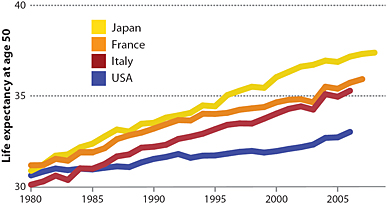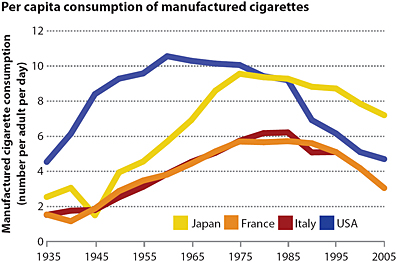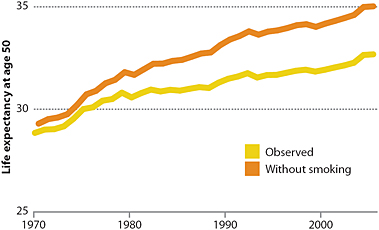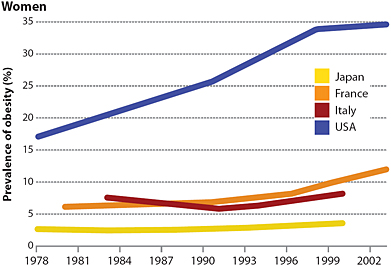Why Don’t U.S. Women Live Longer?
Over the past 25 years, female life expectancy at older ages has been rising in the United States at a slower pace than has been achieved in many other high-income countries, such as France, Italy, and Japan. Consequently, the United States has been falling steadily in the world rankings for level of female life expectancy, and the gap between the United States and countries with the highest achieved life expectancies has been widening. International comparisons of various measures of self-reported health and biological markers of disease reveal similar patterns of U.S. disadvantage. The relatively poor performance of the United States over the past 25 years is surprising given that the country spends far more on health care than any other nation in the world, both absolutely and as a percentage of gross national product. Concerned about this divergence, the National Institute on Aging asked the National Research Council to examine evidence on possible causes. The panel concluded that a history of heavy smoking and current levels of obesity are two factors that are playing a substantial role in the relatively poor performance of the United States. All of the data in the following figures comes from the panel’s report Explaining Divergent Levels of Longevity in High-Income Countries (National Academies Press, 2011).
U.S. women trailing in life expectancy
In 1980, women in the United States, Japan, France, and Italy who reached the age of 50 could all expect to live an additional 30-31 years. Today, women aged 50 in Japan can expect to live an additional 37 years, whereas women in the United States can expect to live only an additional 33 years.

Heart disease and lung cancer are leading culprits
International comparative analysis of cause-of-death data is complicated by variation in coding practice across countries and over time. Nevertheless, it is clear that all four countries have made significant progress in reducing certain leading causes of death such as heart disease over the past 25 years. In contrast, deaths due to lung cancer—a reliable marker of the damage from smoking—have been increasing in the United States.
U.S. women finally foregoing smoking
Three to five decades ago, smoking was much more widespread in the United States than in Europe or Japan, and the health consequences of this prior behavior are still playing out in today’s mortality rates.

It’s the cigarettes, stupid
The yellow line shows the actual trend in female life-expectancy, and the orange line represents what the trend would hypothetically look like if smoking-related mortality were removed. The difference between the two trend lines remained small until around 1975, when it began increasing rapidly. By 2005 it had grown to 2.3 years.

Obesity, the next cause for concern
Other factors, particularly the rapid rise in the level of obesity in the United States, also appear to have contributed to lagging life-expectancy in the United States, but there is still a good deal of uncertainty about the mortality consequences of obesity and how it is changing over time.


